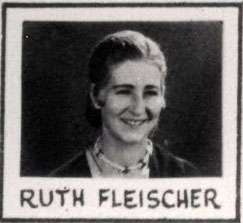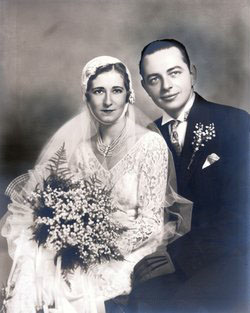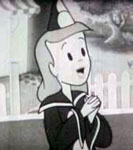Suspended Animation # 212
Ruth F. Kneitel was the daughter of animation producer Max Fleischer who passed away in September 1972 at the age of 89 and was cremated – with his ashes given to his family.
 Ruth passed away of natural causes at ManorCare Nursing Home in Potomac, Maryland in 2001 at the age of 93.
Ruth passed away of natural causes at ManorCare Nursing Home in Potomac, Maryland in 2001 at the age of 93.
She was a professional dancer who appeared in many of her father’s early films mixing live performances with animation. She starred in a series of silent shorts entitled Carrie of the Chorus, and in the cast of a road show in which she interacted with her father’s popular animated character, Betty Boop.
Prior to her marriage, she worked as an artist at Fleischer Studios. In 1931, she married Seymour Kneitel, a head animator at Fleischer Studios. They lived in New York, then later in Miami Beach, Florida when the studio moved to that location. Her husband later became head of Famous Studios.
During that time, Ruth wrote a number of cartoons and also contributed feature articles on historical subjects to several periodicals. She was survived by a son, magazine editor Thomas Kneitel, of Long Island, N.Y.; a daughter, museum designer Virginia Mahoney, of Chevy Chase, Maryland; a brother, film director Richard Fleischer, of Los Angeles, California (who later passed away in 2006), ten grandchildren, and eleven great-grandchildren. A son, Kenneth, died in 1994.
In 1966, she felt her father’s legacy was being overshadowed by Walt Disney so she agreed to write an article for an early limited-edition comics fanzine (The World of Comic Art Vol. 1, No. 2) that appeared in the fall of 1966.
Here is an excerpt from that article:
 “Remember Max Fleischer? Sure you remember him. Any mature adult who went to the movies as a youngster, whether it was here or in China, Russia, Norway or Africa is familiar with the Max Fleischer whose animated cartoons have been making people laugh for almost half a century.
“Remember Max Fleischer? Sure you remember him. Any mature adult who went to the movies as a youngster, whether it was here or in China, Russia, Norway or Africa is familiar with the Max Fleischer whose animated cartoons have been making people laugh for almost half a century.
“And, in this TV age, can there possibly be a child who doesn’t know Koko, Betty Boop and Popeye? But those creations are only a small part of the Max Fleischer story.
“Long after people stop laughing at Max’s pictures, they’ll still be using his inventions, his mechanical improvements, his refinements in production processes that have advanced the motion picture industry so materially in the use of sound, color, and three-dimensional image. And they’ll still be using his teaching methods.
“There is scarcely anyone working in the animated cartoon industry today who has not, directly or indirectly learned his job at the hands of Max Fleischer or a member of his staff.
“The ‘kids’ who fought in the first World War knew Max, too. They learned how to read an army map from his pictures. They learned how to fire the first Lewis machine gun, how to time projectiles, how to handle depth bombs and a Stokes mortar and how to use a rifle grenade.
“A young man by the name of Jamison Handy had convinced Army authorities that motion pictures, properly used by good instructors, could reduce training time. He contacted Fleischer and persuaded him to offer his services as producer.

Wedding portrait of Ruth and Seymour Fleischer
“His job was to come up with answers to the operational problems that gave instructors the greatest difficulty in educating green soldiers and heading the list was, of all things, map reading!
“How to Read an Army Map was the first time animation had ever been used in a training film, and with it he licked one of the Army’s toughest training problems. The farm boy from Kansas, the New England mill hand, the shipping clerk from Chicago, all quickly reacted to this new and painless teaching method.
“Although he was provided with assistants, he had to train each one individually and step-by-step – a time consuming job — and he was literally forced to perfect his animating process. The Army wanted more films as fast as he could turn them out, and necessity being the mother of invention, Max began to devise short cuts. Soon he discovered how to retain the stationary parts of a previous drawing, which saved hours of re-drawing time.

Did Ruth inspire the character of Kokette?
“At least fifteen of the patents he perfected are still in use. One of the most important was a device for photographing cartoons that gave the effect of three-dimensions without the use of special glasses by the audience. The camera he designed to do this work weighed two tons and had a diameter of twelve feet.
“Another achievement was a series of shutters that made it possible to photograph live action and animated motion on the same piece of film. This gave us Koko, the animated clown, dancing around on the lap of his creator, both of whom were in motion simultaneously on the same screen.
“One of his greatest accomplishments was an invention which made it possible to take color pictures in ordinary cameras using a series of filters in conjunction with a special lens. This produced a color register equal to that produced by a special camera costing $30,000 or more.

Ruth’s credit on Paramount’s 1967 cartoon short “Keep The Cool, Baby”
“At present, Max and his wife (still the same wife!) are living in New York. Max himself is what he laughingly calls ‘retired’ but if you think he’s sitting at home twiddling his thumbs, you’ve got another ‘think’ coming.
“He’s busily writing a television play, is working on a new cartoon series on unusual birds and animals, is re-writing and editing his book Noah’s Shoes and is writing two new books…all at the same time.
“Max Fleischer’s life has always been filled with one project after another, and now that’s he’s in his eighties his philosophy is still, as they say in the business, ‘Well, back to the drawing board’.”


 Jim Korkis is an internationally respected animation historian who in recent years has devoted his attention to the many worlds of Disney. He was a columnist for a variety of animation magazines. With his former writing partner, John Cawley, he authored several animation related books including The Encyclopedia of Cartoon Superstars, How to Create Animation, Cartoon Confidential and Get Animated’s Animation Art Buyer’s Guide. He taught animation classes at the Disney Institute in Florida as well as instructing classes on acting and animation history for Disney Feature Animation: Florida.
Jim Korkis is an internationally respected animation historian who in recent years has devoted his attention to the many worlds of Disney. He was a columnist for a variety of animation magazines. With his former writing partner, John Cawley, he authored several animation related books including The Encyclopedia of Cartoon Superstars, How to Create Animation, Cartoon Confidential and Get Animated’s Animation Art Buyer’s Guide. He taught animation classes at the Disney Institute in Florida as well as instructing classes on acting and animation history for Disney Feature Animation: Florida.




















































A nice surprise to see this article by my mother, Ruth! She was a multi-talented woman— dancer, artist, mother, wife- and writer. I can share a story of how she came to work at the studio. As an acrobatic dancer she traveled around the country with a troupe of dancers— which Max and his wife Essie were not happy about! For one thing, on the road she’d been caught smoking! When Max told her to come back home, she said the only way she’d return is if she could work at the studio— she of course was very aware that the studio was a bunch of crazy, fun-loving people who liked to party together. Max finally agreed….. which is how she started her new life, and next career at the studio…
Dynamite! You are the best, cuz.
Tom Kneitel wrote a column for Popular Communications magazine and was a radio ham (W4XAA). He passed away in 2008 at age 75.
http://www.arrl.org/news/prolific-author-tom-kneitel-w4xaa-sk
Wow Ginny!
I didn’t know alot about your Mom and Max too. Great read.
Ruth was a great person, and I had wonderful talks with her over the years. I must say that some of her recollections needed to be fact checked since she admitted that I had researched things that she had forgotten about. One of her areas of confusion was the mention of Jam Handy. She had him confused with John R. Bray. All indications have been that it was Bray who sold the idea of the Army Training films and tf was also at the Bray Studio that OUT OF THE INKWELL began.
Max was acquainted with Bray going back to his start as a Cartoonist at THE BROOKLYN DAILY EAGLE while he was a teenager. And it was Bray who hired Max 13 years later as Production Manager of the Art Department at the Bray Studio. The connection to Jam Handy was that Mr. Handy was a Sales Representative of the Bray Industrial arm and cultivated the automotive accounts. Handy was well acquainted with Max, and it was because of this and Max’s pioneering work in the Army Training films that he brought him is as Head of the Animation Division at The Jam Handy Organization in Detroit in 1942. This was especially important since Detroit was one of the major hubs of manufacturing for the war, and The Jam Handy Organization had been contracted for a large volume of Training Films..
Ruth specifically was Head of the Ink and Paint Department at Fleischer Studios starting in 1929. Story Sessions were open to everyone in the studio on Monday evenings, and Ruth told me that it was in one of those sessions she met Seymour Kneitel. The relationship was so compatible that Ruth and Seymour were married on the evening of Max and Essie’s 26th Wedding Anniversary, December 24, 1931.
While being a mother, she developed many story ideas used for the cartoons without credit. KEEP THE COOL is one of her few Screen Credits 30 years later thanks to Shamus Culhane, who seemed to make the effort to acknowledge the work of women working in the field. He was also one of the promoters and supporters of Lillian Freeman.
There’s a good example of Ruth Kneitel’s dancing in rotoscope in the 1922 Inkwell cartoon “Mechanical Doll” (also known as “Dresden Doll” or “Dancing Doll.” A restored print can be found on the DVD “Accidentally Preserved Vol. 1.”
I’d argue that even today the legacy of Max Fleischer is undervalued. Yes, the best Fleischer shorts are the wacky 30s cartoons even wackier then modern day cartoons that try to be wacky 30s cartoons, and they have rightfully gained a following and continue to inspire artists, but things like Max’s inventions are only even relatively known by vintage animation circles. Disney, both the studio and the man, have a lot of interesting and fascinating things about them, yes, but Fleischer had a lot of interesting things as well.
Ever since I first started watching the Fleischer cartoons, I’ve always kind of preferred Max Fleischer over Walt Disney.